Gripper searches for the right place to harvest gerbera
Added on 23 February 2021

Grippers are the robot parts that grasp an object. WUR has knowledge and experience in this regard with various crops. Each of those crops has its own characteristics to which the gripper design must be adapted. For example, a gerbera has a thin, long stem. That means the robot gently 'hugs' the stem and then descends down to the best place to harvest the stem.
Picking or cutting
WUR currently investigates two solutions: picking or cutting. Picking is preferred for manual harvesting. This is fast and no stems remain in the crop. When picking, the stem must be pulled in the right direction: if this is not done, the crop can be damaged. This is difficult for the robot to determine. That is why force sensors check that the gripper does not experience too much resistance, and thus pulls to the wrong side.
With a harvesting robot that cuts, there is another challenge: the gripper has to go down as far as possible to cut. That is a difficult movement in a place that is hard to reach. A disadvantage of this method is that pieces of stem remain, the WUR is investigating whether this may have adverse effects.
Prototypes of both harvesting techniques - picking and cutting - are first developed that can be operated manually in order to gain insight into the feasibility of the concepts. Ultimately, the best concept is further developed into an end-effector that is placed on the robot arm and controlled by the control software.
The research into the gerbera harvesting robot is a public-private partnership and is funded by the Gerbera crop cooperative and the Horticulture & Propagation Materials Top Sector.?
Source and Photo Courtesy of Wageningen University & Research
Source: Wageningen University & Research
More news















